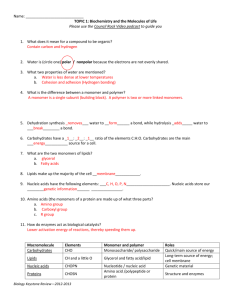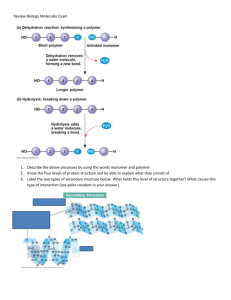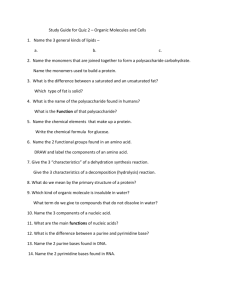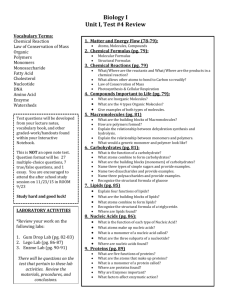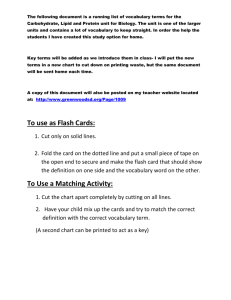Name: Date: Academic Review Sheet: Organic Chemistry
advertisement
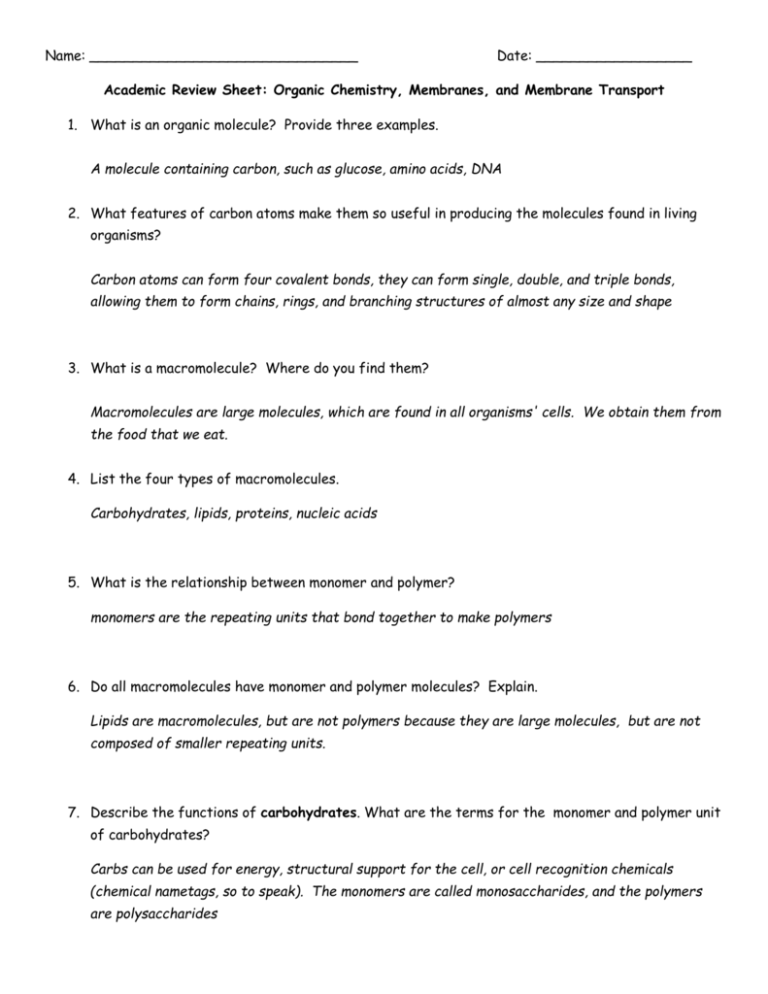
Name: _______________________________ Date: __________________ Academic Review Sheet: Organic Chemistry, Membranes, and Membrane Transport 1. What is an organic molecule? Provide three examples. A molecule containing carbon, such as glucose, amino acids, DNA 2. What features of carbon atoms make them so useful in producing the molecules found in living organisms? Carbon atoms can form four covalent bonds, they can form single, double, and triple bonds, allowing them to form chains, rings, and branching structures of almost any size and shape 3. What is a macromolecule? Where do you find them? Macromolecules are large molecules, which are found in all organisms' cells. We obtain them from the food that we eat. 4. List the four types of macromolecules. Carbohydrates, lipids, proteins, nucleic acids 5. What is the relationship between monomer and polymer? monomers are the repeating units that bond together to make polymers 6. Do all macromolecules have monomer and polymer molecules? Explain. Lipids are macromolecules, but are not polymers because they are large molecules, but are not composed of smaller repeating units. 7. Describe the functions of carbohydrates. What are the terms for the monomer and polymer unit of carbohydrates? Carbs can be used for energy, structural support for the cell, or cell recognition chemicals (chemical nametags, so to speak). The monomers are called monosaccharides, and the polymers are polysaccharides 8. Provide FOUR specific examples of carbohydrate polymers (polysaccharides), and their functions, by completing the chart below: Glycogen - polysaccharide found in animals' muscles and liver used for energy storage Starch - polysaccharide found in plants, used for energy storage Chitin - polysaccharide found in lobster and crab (crustacean shells) used for structure/support Cellulose - polysaccharide found in plants and some other organisms that composes the cell wall for support/structure 9. In what types of food do you find a lot of carbs? vegetables (starches), fruits (sugars), breads, cereals, candy 10. Describe the functions of lipids. Also, describe the differences between saturated and unsaturated fats. Unsaturated fats are made of lipids with bent fatty acids tails, which pack more loosely, and are liquids at room temp. 11. What types of foods are high in lipids? Nuts, red meat, avocadoes, fish, oils 12. Describe the functions of proteins, with EXAMPLES. What are their monomer and polymer units? proteins are the workhorses of the cells, and do many functions, such as structural (collagen), movement (muscle protein), running chemical reactions (enzymes), and immunity (antibodies) 13. What types of foods are high in protein? Fish, meat, nuts, 14. What are the functions of nucleic acids? What are their monomer and polymer units? Nucleic acids are polymers made of nucleotide monomers. DNA is an important example of a nucleic acid, and serves as the chemical blueprints to build calls and organisms 15. How do cells break apart polymers into monomer? Use the specific term, and draw a picture. Hydrolysis reaction - breaks polymers into monomers by splitting water molecules. 16. How do cells connect monomers into polymers? Use the specific term, and draw a picture. Dehydration synthesis: the opposite process of hydrolysis 17. Describe two scenarios in which your cells would need to break apart, or build a polymer. to build new DNA for a new cell, to break starch down from a potato you just ate into glucose monomers, to build new muscle tissue out of amino acids that you ate after a workout 18. What is a free radical? Draw a picture of a free radical atom below. Free radicals are atoms without a full valence shell. They are highly reactive, and can damage cells, and DNA. 19. What is an antioxidant? Draw a picture showing how an antioxidant would combat a free radical. Antioxidants are molecules, like certain vitamins, that react with free-radicals, and make free radicals non-reactive. They help to keep our cells and DNA safe from free radical damage. 20. Where can you get antioxidants from? Healthy foods like fruits and vegetables 21. .What is a membrane? Is the cell membrane the only membrane in the cell? Provide examples. A membrane is the covering of a cell, or organelle, composed of two layers of phospholipids. Examples are the cell membrane, nuclear envelope 22. What is the function of the cell membrane? Use the term selectively permeable. To regulate what enters or exits the cell. it is selectively permeable to certain molecules, such as small, nonpolar substances. 23. What are the basic structures that make up all membranes? Draw a little diagram (make sure it’s a bilayer). phospholipids, composed of glycerol head and two fatty acid tails 24. What is the basic structure of a phospholipid? Use the terms hydrophilic and hydrophobic in your response composed of glycerol head and two fatty acid tails. The head is hydrophilic, and the tails are hydrophobic. 25. What important roles do proteins play that are embedded in the membranes of all organelles? Provide examples. Allow for transport of certain molecules into/out of the cell, serve as enzymes to run chemical reactions, can be receptors, transmitting chemical signals into the cell, can anchor or attach cells to other cells 26. What is diffusion? Provide an everyday example. the movement of molecules from higher to lower concentration, such as the spreading out of perfume when sprayed 27. Which type of diffusion requires the use of a carrier protein? facilitated diffusion 28. What are the differences between passive and active transport? passive transport occurs without the use of energy by the cell from higher to lower concentration. Active transport is the movement of molecules from lower to higher concentration, it requires the use of a protein, and requires the cell to expend energy 29. Is facilitated diffusion, using a carrier protein, passive or active? passive 30. How would a cell move very large items, like nutrient droplets or bacterial cells into/out of cell? What is the name of the process? endocytosis - bulk transport in, exocytosis - bulk transport out 31. What is the term for the movement of water from an area of high concentration to low concentration? Osmosis 32. Explain what type of environment each cell is immersed in for each picture. Use the terms hypertonic, hypotonic, and isotonic. hypertonic isotonic very hypotonic hypertonic isotonic hypotonic 33. What is a concentration gradient? a difference in the concentration of a substance over a given area 34. True or false: Diffusion will occur at a slower rate when there is a steeper concentration gradient __ 35. Explain your answer below. false...the large the gradient, the faster the rate of diffusion 36. Why is the sodium potassium pump an important protein for living organisms (use the term active transport in your response). the sodium potassium pump is a protein embedded in the cell membrane of cells. it actively pumps sodium out of the cell, and actively pumps potassium into the cell. Cells like neurons rely on the steep concentration gradient of sodium, and potassium, in order to send messages through nerves 37. Which types of substances are able to pass through the phospholipids of the cell membrane? Which are not able to pass through the phospholipids. Explain why. small and nonpolar substances have the greatest chances of passing through the phospholipids. Larger, charged, and polar substances are not able to pass through the phospholipids. 38. What is meant be the fluid mosaic model of membranes? fluid - phospholipids can slide/squeeze past one another 39. In the box below, draw a section of a phospholipid bilayer, containing membrane proteins. Refer to notes/text book/ internet for reference

